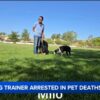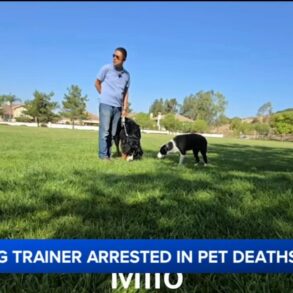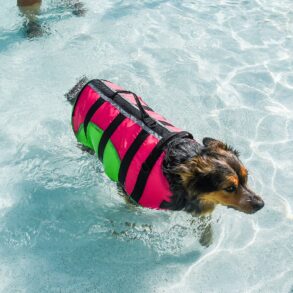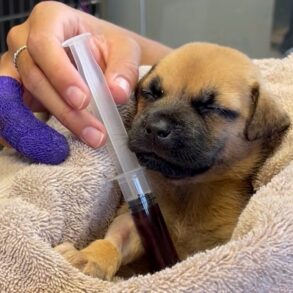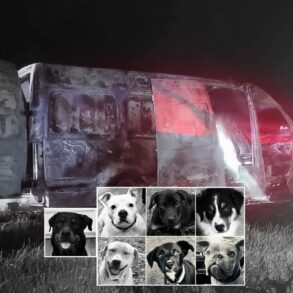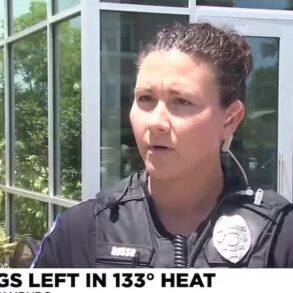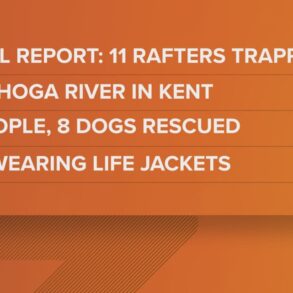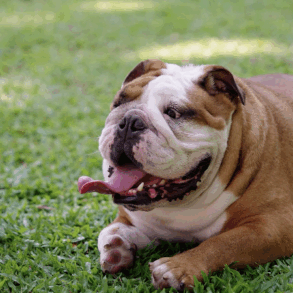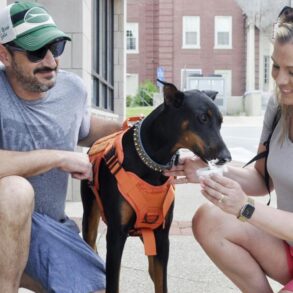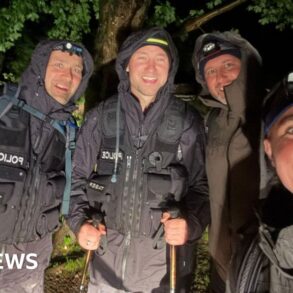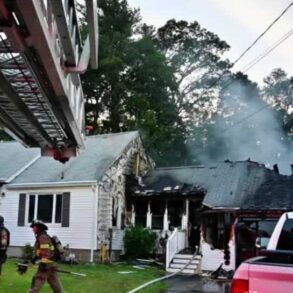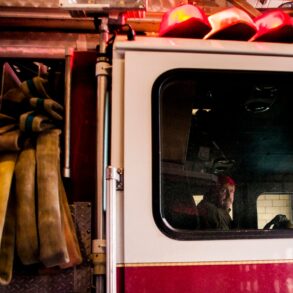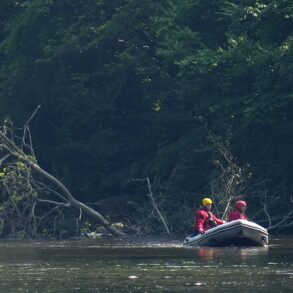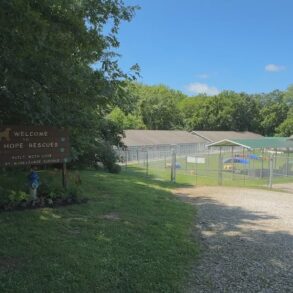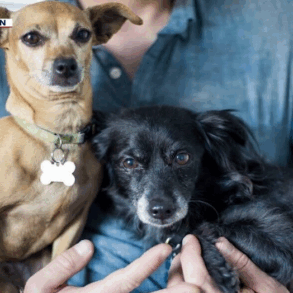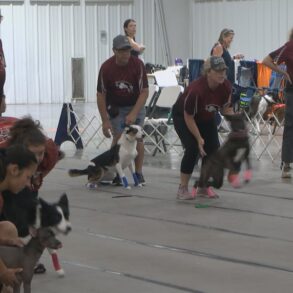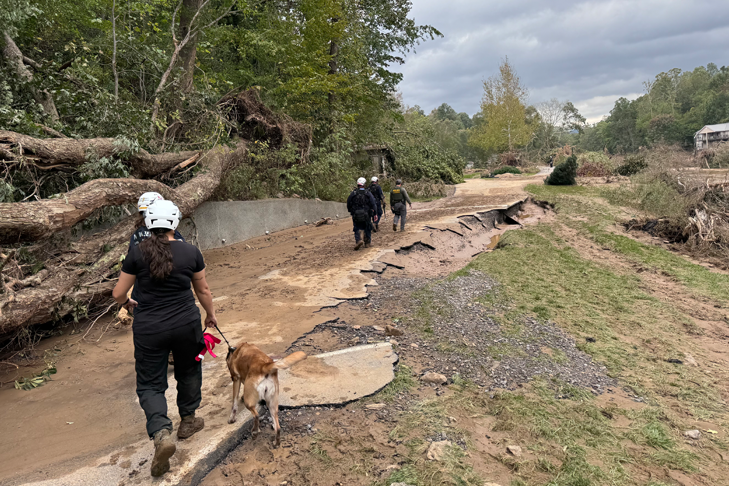
Over a week after making landfall, the catastrophic damage as a result of Hurricane Helene was still felt across the southern United States. Many communities lost power, and were disconnected from support. The Federal Emergency Management Agency (FEMA), as well as search and rescue dog teams, responded to the area to find victims trapped by the storm. These brave and highly trained dog-and-handler teams are working in difficult and dangerous conditions, often as volunteers, trying to provide help to victims and their families.
What Kind of Working Dogs Go to Sites?
There are multiple specialized types of work that dogs can perform in a disaster area of this size and magnitude. Hannah Davis, the founder of East Carolina Search and Recovery explains that generally, the first dogs who go into a site like this are FEMA dogs. These dogs are experienced with working on large piles of rubble and are certified to work on these types of very dangerous search sites.
Dogs working rubble piles must be highly trained and skilled, including being able to perform what Davis describes as “intentional disobedience.” When searching for victims, the handlers are often on the ground, while the dogs are going up into rubble to search for victims. If the handler cues a dog to do something and the dog knows it can’t be done safely, they must intentionally disobey their handler to stay safe.
In addition to searching the rubble, dogs are also searching through mudslides, wilderness areas, collapsed buildings, as well as on the water through areas that have been flooded. Over a week after Hurricane Helene hit, recovery efforts continue in the surrounding areas. Despite the devastation caused by the storm, there continues to be live rescues of people even in remote areas. “This speaks to the resiliency of Appalachia and North Carolina. These are people who are used to what mountain life can mean in a rural context,” Davis says.
Volunteer Teams on the Ground After Disaster
It’s hard work for dogs and handlers responding to Hurricane Helene to even access some of the most impacted areas. Before Helene, western North Carolina was already remote, Davis explains. But now, many roads and bridges are completely washed away and infrastructure in the area is crumbling. She notes that safely inserting trained dogs and handler teams into the area isn’t as simple as just driving a four-wheel drive vehicle and being on the ground with your dog. The North Carolina Emergency Management System is managing the deployment of appropriately trained, skilled, and certified dog and handler teams into the impacted areas as quickly as possible. Davis and her dogs are on standby preparing to possibly deploy into hurricane-impacted areas as the work shifts to human remains recovery.
David stresses that it’s very important that dog and handler teams do not “self-deploy.” Instead, they should wait until they’re called up to respond. Even certified search teams may not be prepared for how challenging conditions are, she cautions. Dog-handler teams that are unable to handle the dangerous terrain could inadvertently cause harm by endangering themselves or their dogs, which could require a diversion of emergency efforts.
It takes approximately two years to train these highly skilled dogs before they can begin working. Something unique about remains detection dogs is that while the teams work closely with and are dispatched by emergency responders and law enforcement, most teams are volunteers. “90-95% of the dogs are volunteers,” Davis explains. “Very few of us are paid, very few of us are law enforcement.” She also notes that human remains detection work is a woman-dominated field and that the majority of handlers on the front lines working human remains detection dogs are women.
Tackling Unbelievable Disaster Conditions
The current conditions on the ground in North Carolina are extremely challenging and dangerous for dogs and handlers to navigate. “It was the worst thing I’ve ever seen in my life, and I’ve been doing this for 25 years,” explains Jack Thorp, Director and K9 Handler with NC Trooper’s Association K9 Search & Recovery who spent 10 days on-site with German Shepherd Dog “Fiji.” Dog and handler teams who are currently deployed are working 14 to 16-hour days, searching in water, mud, and through debris piles.
Along with the NC Troopers Association Team, Annissia Justice, NC Troopers Association Assistant Director, and her Belgian Malinois, “Dahlia,” have worked long days moving between search areas. On any given day, they could spend eight hours searching in mud, four hours in a collapsing structure, and another four to five hours on the water in a boat out in the sun. Not only is the work difficult and exhausting in the best of conditions, but search conditions are especially challenging for dogs because of the mud, which can be up to 18 inches high and is treacherous to navigate.
Even experienced search and rescue dogs can struggle with all the complexities of this environment. “If you don’t have a dog with super stable genetics and lots of drive, the first brier patch or mudhole they fall into, they would have been done. Just having that stability on the types of dogs that we choose to work is super important,” Justice explains. She notes that the dogs chosen to participate in rescue efforts all have the ability to go above and beyond to do their job. Because of the damage the storm did to homes, businesses, factories, and other infrastructure, all mud must be treated as though it’s hazardous and contaminated, according to Davis. This requires both dogs and handlers to be decontaminated every 30 minutes, while working to prevent them from getting exposed to toxins.
Displaced wildlife in the area are also causing additional challenges for dogs and handlers. Just like humans, much wildlife was also displaced by the storm. Bear, elk, bobcats, and deer are among the animals presenting safety and logistical challenges. The biggest issue right now is yellow jackets. This time of year, these insects generally are bedding down. However, the floodwaters have displaced them, creating a dangerous situation for the working dogs and their handlers.
Because of how physically demanding conditions are, teams are rotating in and out of deployments regularly. This work is physically and emotionally exhausting for handlers, as well as extremely physically demanding for the dogs. Following their 10-day deployment, Justice and her dogs are driving back home, where the dogs will get fully groomed, examined at the vet, and get plenty of rest.
Difficult Scents to Track
The work that dogs do to search disaster areas by scent can’t be replicated by drones or other technology. Lives are saved, and bodies are recovered because of the incredible strength, bravery, and heroism of these dogs and handlers. Cat Warren, the New York Times bestselling author of “What the Dog Knows: Scent, Science, and the Amazing Ways Dogs Perceive the World,” explains that the search conditions after Hurricane Helene are difficult. The dogs who are working these recovery efforts are the best of the best.
Warren notes that the sheer overwhelming amount of odors at a site like this can make working hard even for experienced dogs. Dogs are having to sift through the scents from the flood, spilled chemicals, damaged buildings, and wild animals. Working through these difficult scent conditions makes the effort and successes of the on-the-ground teams even more impressive.
A coordinated search of all impacted areas spanning 25 counties, many of which are geographically isolated in the mountain, is taking place. As teams clear an area, they move onto the next search site. Dogs see the world through their nose, but they need the scent to be able to reach the surface for dogs to detect it.
Because of the shifting conditions with mudslides and receding water, many areas will need to be searched again in the future, according to Warren. As the mud continues to move, shafts of air will emerge, which will help more scent reach the surface for dogs to find. Dog-handler teams agree that the recovery work for all Hurricane Helene-impacted areas will be ongoing. Due to the size of the disaster and the complicated conditions in the area, it’s likely that human remains dogs could be working in the area for months to come.
Jobs That Feel Like Play for the Dogs
Many working dogs are high-drive dogs who live for the opportunity to perform their jobs. Justice’s dog Dahlia is famous among the search teams for her love of squeaky toys, specifically the KONG Wubba. She has a huge collection of Wubbas, including different seasonal ones for Halloween and Christmas that she brings to work. “Everything is so serious. There are literal fires from a train derailing, and Dahlia’s there squeaking!” Thorpe explained about his colleague’s dog.
Watching the dogs play helps to lighten the mood for the handlers and emergency responders. They say that interacting with the dogs can help keep them going after a long day when they’re wet, sore, and tired. “Everyone thinks that they are upset after doing a difficult job, but they don’t have those human emotions we have. At the end of the day, they are just happy to earn their toy,” says Justice. These dogs have the genetic drive to do these jobs and simply love their work.
This post was originally published on this site be sure to check out more of their content.



